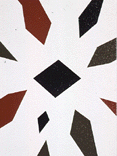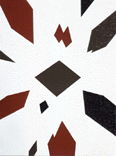Stephen Bram And a
Relativistic Felicity Coleman |
Stephen Bram, Untitled,
oil on canvas, |
Stephen Bram And a
Relativistic Felicity Coleman |
Stephen Bram, Untitled,
oil on canvas, |
| Absolutism and relativity are two appositional philosophies with regard to the human mind's perception of knowledge and the states of objects. Each structure of thought appears to exclude the other and so produces a feeling of a framed idea, a hypothesis which obstructs an arriving at any true decision about a subject or object. Stephen Bram's work exhibits all the tendencies of such appositional perimeters; those contrary thoughts by which people apply known sets of criteria to make a judgement about something. How does one grasp a sense of the unknown or the unknowable - only via a reconstruction of our own relative ideas about the absolute. These rhetorically adverse ideas create conceptual relationships which require a shift in perception and an adjustment in the thinking of meaning in relation to standard or idealised models of representation. | |
 Stephen Bram, Untitled, |
Stephen Bram's recent
exhibition of paintings at Anna Schwartz Gallery in
Melbourne created such a relationship (one between the
praxes of beauty and abstraction). The conceptual leap
provided by Bram's work sees us through the intellect of
both utopian ideas and creates an invisible fat chair -
fuel for the mind to grasp the unknown or the not yet
representable. The paintings were in Bram's trademark degraded colours highlighting the preference of the intellect over retinal perception. It was Bram's architectonic compression of space organised to its purist, sparsest crystallisation of form.1 In these works, the quantity of space is pared down to its most essential and most joyous method of creation. |
| The praxis of beauty throughout history is akin to the ways in which abstract representation this century has been recorded as a set of examples for practice, a habit or a particular custom. A praxis does not follow any absolute theory but is relativistically determined. Examples of these might be the Russian constructivist Kasmir Malevich searching for his own particular utopian god or ideal representation, the Dutch Theo Van Doesberg's De Stijl group wanting to instil a sense of order into a chaotic world or Wassily Kandinsky teaching proposing a perfect visual representation of the language of music. | |
 Stephen Bram, Untitled,
|
But if these historical
examples are all from the canon of modernist abstraction
and as such represent exemplar versions of
abstract praxis, Bram's work has a prepatory premise
which contradicts the sense of practice which is produced
by different culture's social and political situations.
The praxis of abstraction is often thought of as a
preliminary theory or a conclusive point rather than
considered relatively. What Bram offers is a renewal of
abstraction via a new relationship with the modernist
avant-garde. The purity their works expressed was, like
Bram's, a constructed articulation of their particular
invented visual languages. It was a language where
elements are pared down, manipulated, rearranged and
presented as a system of coded communication. This theory
of form equalling content to provide a pure vehicle for
emotions and existence was announced as the idea, or even
the reason why people need to make art. Bram's work
considers how it is that such a constructed ideal does in
fact already exist in nature, as in the pure geometrical
forms of crystals, which these paintings emulate.2 Bram's relationship between the relative and the absolute has resulted in the production of beautiful forms, beautiful as a utopic community which already exists in our world, yet waiting to be discovered; waiting for a language which can, as an expressive structure, articulate its boundaries. Its distinctive taste and style thus represent its particular praxis of beauty. Felicity Coleman Endnotes |